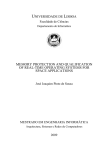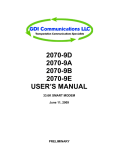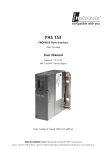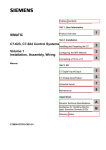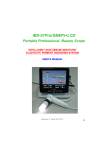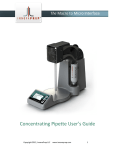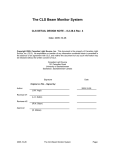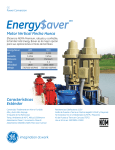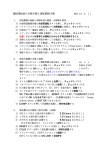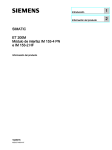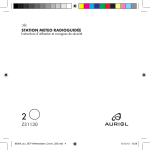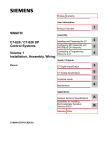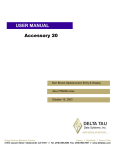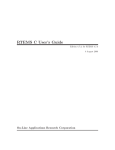Download - Canadian Light Source
Transcript
REVISION HISTORY Revision Date Description Author A 2000-01-10 Draft. W. Eric Norum 0 2000-01-10 Issued for use. W. Eric Norum B 2001-06-25 Updated to reflect revised design. Issued for Review. E. D. Matias C 2001-07-18 Incorporated comments from M. Heikoop. Added Appendix B, C, D and E covering rationale for reliability targets and design guidelines. E. D. Matias 1 2001-08-21 Incorporated comments from J. Vogt, M. de Jong, E. D. Matias G. Wright, N. Johnson, S. Abell-Smith, and L. Dallin. This document supersedes and replaces CLS 2.1.39/8.2.60.1. Issued for use. 2A 2002-03-27 Updated for use in beamlines procurement. Incorporates improved discussion of motion control, beamlines interface, updated development process, CSA electrical standards, and expanded operator interface/human factors discussion. Removed discussion of Cisco IP SoftPhone. 2 2002-04-24 Added specific equipment model numbers and E. D. Matias incorporated reviewer comments. Issued for use. Control System Technical Specification E. D. Matias 1 Table of Contents Page 1.0 Introduction........................................................................................................... 5 1.1 Purpose................................................................................................................ 5 1.2 Scope................................................................................................................... 5 1.3 Background ......................................................................................................... 5 1.4 Development Plan and Process........................................................................... 6 2.0 Functionality.......................................................................................................... 7 2.1 Control ................................................................................................................ 7 2.2 Diagnostic ........................................................................................................... 7 2.3 Machine/Equipment Protection........................................................................... 8 2.3.1 Linac Transmitter Protection ...................................................................... 8 2.3.2 Magnet Protection....................................................................................... 9 2.3.3 Vacuum Protection...................................................................................... 9 2.3.4 Water Cooling System ................................................................................ 9 2.4 Personnel Safety.................................................................................................. 9 3.0 Architecture ......................................................................................................... 10 4.0 Operator Interface .............................................................................................. 13 4.1.1 Operator Control Screens.......................................................................... 13 4.1.2 Alarm Handling......................................................................................... 14 4.1.3 System Configuration Database................................................................ 15 4.1.4 Knob Boxes............................................................................................... 16 4.1.5 Strip Tool and SDDS ................................................................................ 16 4.1.6 Problem Tracking and Event Logging ...................................................... 17 4.1.7 Pop-Up and Image and Transition Radiation Monitor Software .............. 18 4.1.8 Auto Telephone Dialler............................................................................. 18 4.1.9 Instrumentation ......................................................................................... 18 4.1.10 Printers ...................................................................................................... 18 4.1.11 Common Graphical Displays .................................................................... 18 5.0 Input Output Controller..................................................................................... 19 5.1 EPICS IOC Software ........................................................................................ 19 5.2 Single Board Computers (Motorola 68360 Processor)..................................... 19 5.3 Single Board Computers (PC-104) ................................................................... 19 5.4 Industrial PC Hardware..................................................................................... 20 6.0 Device Level......................................................................................................... 21 6.1 VME Hardware ................................................................................................. 21 6.2 VXI Hardware................................................................................................... 21 6.3 PLC Hardware................................................................................................... 21 6.3.1 MODICON Momentum............................................................................ 21 6.3.2 Siemens Simatic S7/300, S7/400 and S7/400F ......................................... 22 6.3.3 Gould/MODICON Micro84...................................................................... 23 6.3.4 Telemecanique TSX-17 ............................................................................ 23 6.4 Invensys DMS................................................................................................... 23 6.5 RS232/RS485 Devices ...................................................................................... 23 6.6 GPIB Devices.................................................................................................... 25 6.7 Ethernet Based Devices .................................................................................... 25 Control System Technical Specification 2 7.0 Timing System..................................................................................................... 26 7.1 Signal Distribution............................................................................................ 26 7.2 Facility Clock .................................................................................................... 26 8.0 Secondary Systems .............................................................................................. 27 9.0 Control System Servers ...................................................................................... 28 10.0 Networking .......................................................................................................... 29 10.1 Network Configuration..................................................................................... 29 10.2 Subnets/VLAN .................................................................................................. 29 10.3 Beamlines OPI and IOC Connection................................................................ 29 11.0 System Software .................................................................................................. 30 11.1 Experimental Physics and Industrial Control System (EPICS) ........................ 30 11.2 Real-Time Executive for Multiprocessor Systems (RTEMS) .......................... 30 11.3 RedHat Linux.................................................................................................... 31 11.4 MS-Windows 2000, MS-Windows NT 4.0 and MS-Windows 98 ................... 31 11.5 Interactive Graphical Supervision System (IGSS) ........................................... 31 11.6 InView............................................................................................................... 31 11.7 Siemens Touch Panels (MS-WinCE)................................................................ 31 12.0 References............................................................................................................ 32 Appendix A: Consideration For Suppliers ................................................................... 34 A.1 Non-Technical Requirements................................................................................. 34 Appendix B: Reliability Targets .................................................................................... 35 Appendix C: Hardware Guidelines............................................................................... 36 C.1 High Voltage .......................................................................................................... 36 C.2 Signals .................................................................................................................... 36 C.3 Electrical Safety ..................................................................................................... 37 C.4 Hardwired Controls ................................................................................................ 37 C.5 Electronics.............................................................................................................. 37 C.6 Motion Control....................................................................................................... 37 C.7 Environmental ........................................................................................................ 37 C.8 Cabling ................................................................................................................... 38 C.9 CAMAC ................................................................................................................. 38 C.10 CompactPCI/PXI.................................................................................................. 38 C.11 FASTBUS ............................................................................................................ 38 C.12 FieldPoint ............................................................................................................. 38 C.13 NIM ...................................................................................................................... 38 C.14 PLC Hardware ...................................................................................................... 39 C.15 VME ..................................................................................................................... 40 C.16 VXI ....................................................................................................................... 41 Appendix D: Software and Computer System Development Guidelines .................. 42 D.1 Computer System and Software Design ................................................................ 42 D.2 Configuration Management ................................................................................... 42 D.3 Comp uter Programming Languages ...................................................................... 42 D.4 Computer Program Structure ................................................................................. 43 D.5 Signal Naming Convention.................................................................................... 43 D.6 Standard System Software ..................................................................................... 44 D.7 Standard Development Tools ................................................................................. 44 Control System Technical Specification 3 Appendix E: Operator Interface Guidelines................................................................ 45 E.1 Structure of The Control System Screens .............................................................. 45 E.2 Standard State Machine Model .............................................................................. 46 E.3 User Screens ........................................................................................................... 47 Appendix F: Motion Control ......................................................................................... 49 F.1 Microstep Rate .................................................................................................... 49 F.2 Supported Motors ............................................................................................... 49 F.3 CW Limit, CW Limit Return.............................................................................. 49 F.4 CCW Limit, CCW Limit Return ........................................................................ 49 F.5 Brake, Brake Return ........................................................................................... 49 F.6 Position Feedback ............................................................................................... 50 Appendix G: Control System Abbreviations and Acronyms ...................................... 51 Figures Page Figure 1 – Control System Architecture ........................................................................... 10 Figure 2 – Sample MEDM Control Screens ..................................................................... 14 Figure 3 – Sample EDM Screen ....................................................................................... 14 Figure 4 – Alarm Handler ................................................................................................. 15 Figure 5 – Cables Database............................................................................................... 15 Figure 6 – Knob Box Management Software ................................................................... 16 Figure 7 – Strip Tool......................................................................................................... 17 Figure 8 – Problem/Event Logging................................................................................... 17 Figure 9 – IOC Software Structure ................................................................................... 19 Figure 10 – MODICON Momentum Interface ................................................................. 22 Figure 11 – PROFIBUS Interface ..................................................................................... 23 Figure 12 – RS232/RS485 Interface ................................................................................. 24 Figure 13 – GPIB Device Interface................................................................................... 25 Figure 14 - Structure of Operation Interface Screens ....................................................... 45 Figure 15 – Standard CLS Equipment State- machine ...................................................... 46 Figure 16 – SNS Colour Scheme ...................................................................................... 48 Tables Page Table 1 – Control System Server Services ....................................................................... 28 Table 2 – Example Network IP Name Assignment .......................................................... 29 Table 3 – APS Reliability Record..................................................................................... 35 Table 4 - CLS Standard MODICON Momentum Modules .............................................. 39 Table 5 - CLS Standard Siemens S7/300 Modules........................................................... 39 Table 6 - CLS Standard S7/400 H Series Failsafe Modules ............................................. 40 Table 7 - CLS Standard VME Modules............................................................................ 40 Table 8 - CLS Standard VXI Modules ............................................................................. 41 Table 9 – Standard CLS Equipment Operating States ...................................................... 47 Control System Technical Specification 4 1.0 Introduction 1.1 Purpose This document describes the Canadian Light Source (CLS) control system. Guidelines for equipment suppliers that must interface with the CLS control system or are supplying software and hardware systems that will form part of the control system are given in Appendix A, C, D and E of this document. Suppliers may deviate from these guidelines only with the prior acceptance of CLS. 1.2 Scope This document provides an overview of the control system architecture. Specific functional requirements and detailed design are included in the relevant system component manuals. A common list of acronyms and abbreviations for all of the control system documentation is included in Appendix F. 1.3 Background The control system must meet the requirements of different classes of users. For example, machine operators need to be presented with a concise, clear and timely representation of the current state of the machine and how the current state compares with the historical operation of the machine. They need to be quickly notified of the presence and severity of any alarm conditions. Experimenters need to know the values of a limited set of machine parameters and need to be able to control a very limited set of machine components. Accelerator physicists need to be able to easily and quickly make changes to the operation of the machine to perform studies and verify their hypotheses. Maintenance staff need accurate logs of machine operation with concise reports indicating the location and nature of equipment requiring maintenance. Safety personnel need ready access to radiation and environment monitoring information. The control system must be reliable enough to ensure that beam time is not significantly affected. An unavailability target of 0.5% of scheduled beam time is being used as a basis for the design of the control system. Redundancy or fault-tolerant hardware will be used where cost effective. Hardware will be chosen or designed to provide minimum Mean-time-to-repair durations. Plugable subsystems will be used wherever possible. To the greatest extent possible common components will be used within the facility and approximately 15% spares will be maintained on hand. Continuous monitoring and archiving of control system process variables will be used to provide advance warning of components nearing failure. Performance of the control system must be high enough to ensure that responses to operator actions are applied quickly enough so the control system does not present a significant delay in the man-machine loop. Wherever possible, taking into account the speed of actual actuators and transducers, the time taken to accept the operator action, to send it to a device under control and to report any status changes resulting from that action should be less than 150 milliseconds. Clearly this is impossible for actions which affect the booster operating at 1 Hz, but at the very least the operator should be presented with immediate feedback that the command has been accepted and is in progress. Hard real-time constraints such as those imposed by the fast orbit-correction system must also be met. Given the required sampling frequency and the number of inputs and outputs associated with the fast orbit correction it should not be difficult to implement this function within the control system. Control System Technical Specification 5 The control system must be scalable to allow for future additions to the facility. This includes increases in the numbers of signals monitored and controlled as well as increases in the numbers of beamlines and other external devices requiring access to control system values. 1.4 Development Plan and Process The Control System Development Plan (Matias 2001) and the CLS Project Implementation Manual (CLS 2001) outlines how the CLS control system is being developed. A series of development guides and procedures provide detailed guidance on the work processes being used in the development of the control system, such as the source code configuration management procedure (Wright 2002a). The Human Factors Work-scope (Davey 2001) discusses how human factors are considered in the design of the CLS facility including user interfaces within the context of the Canadian Nuclear Safety Commission guidelines. Operator interface guidelines are based on a combination of best practice, industry norms (Gurd and Dadson 2002) and local operational experience. These are listed in Appendix E. A component manual is developed for each of the key area of the facility and each beamline. The component manual describes the functional behaviour of the software, the design and provides guidance on the use of the control system. The software design is captured in a mix of documentation and drawings. Control system drawings are in part based on the Unified Modeling Language, (OMG 1999). Process and Instrumentation Drawings (PID) describe how the control and diagnostic system are logically connected to field equipment and loop drawings define the physical connections. In addition design notes are developed for generic software and hardware components. Either a generic or project specific test procedure is applied when integrating and commissioning each of these systems. Where possible CLS purchases electronics commercially, however this is not always possible and a capability to design, manufacture and repair custom electronics is maintained. Vogt (2002) defines the processes followed in developing, manufacturing and testing custom electronics. Control System Technical Specification 6 2.0 Functionality 2.1 Control The CLS control system is responsible for the monitoring and control of the technical components of the facility machine and beamlines. These functions include the: (a) electron gun; (b) equipment timing; (c) beam steering (magnet power supplies); (d) accelerating section (RF, phase, attenuation, temperature control); (e) slit drives; (f) booster and storage ring RF, (g) vacuum (valves, pumps, pressure transducers); (h) cryogenics; (i) orbit correction; (j) insertion devices; (k) beamline monochromators; (l) endstation instrumentation; (m) movable photon masks; (n) temperature monitoring; (o) storage ring air handling; (p) electrical switch yard monitoring and power metering; (q) water cooling systems; (r) radiation monitoring; and (s) beam shutters. The structure and interface of the beamlines control software with the rest of the facility control system is under development and will be incorporated into the next revision to this document. In addition the control system interfaces with the following semi-autonomous systems: 2.2 (a) fire protection system, (b) security system, (c) video surveillance system, and (d) Heating Ventilation and Air Conditioning (HVAC) System. Diagnostic The linac, transfer lines, booster and storage ring are heavily instrumented (Vogt 2001a and 2001b) to aid in setting up the machine, controlling operation of the machine and diagnosing problems that may arise. Readout from most instrumentation is performed through the control system. These diagnostics include: (a) Pop-ups in the linac and booster. Pop-ups are used to determine the position and shape of the beam. (b) Transition Radiation Monitors (TRM) in the transfer lines. TRMs are used to determine the position and profile of the beam (Wishart 2000). Control System Technical Specification 7 (c) Synchrotron Light Monitor (LM) in the booster. LMs are used to detect the presence of the beam. (d) Cerenkov Beam Loss Monitors (CBLM) in the linac and transfer lines. CBLMs are used to monitor beam loss over short periods of time. (e) Bergoz Beam Loss Monitors (BBLM) in the booster and storage ring. Pin-diode BBLMs are used to measure beam loss over a longer period of time. (f) Beam Position Monitors (BPM) in the booster. BPMs are used to monitor the position of the beam. (g) Beam Position Monitors (BPM) in the storage ring. i. Most buttons are connected to Bergoz electronics and VME ADC cards. These are used to measure the position of the beam and are used for orbit correction. ii. One set is connected to a spectrum analyzer for tune measurement. iii. One set can be connected to a sampling oscilloscope for pulse profile measurement. 2.3 iv. One set is used to provide beam-based timing to beamline users. v. A series of additional sets are allocated for future use (i.e., limited first turn beam position measurement and transverse feedback). (h) Strip Line Monitors (SLM) in the booster are connected to a spectrum analyzer and tracking generator. The SLM provides tune measurements. Additional SLMs are located in the transfer lines for future use. (i) Integrating Current Transformers (ICT) in the transfer lines. These are used to measure the charge in a pulse train. (j) Fast Current Transformers (FCT) in the linac, booster and transfer lines are used to measure the profile of the 500 MHz bunch train. (k) Parametric Current Transformers (PCT) in the booster and storage ring are used to measure the current in the ring with a high precision. In the storage ring the measurement is averaged over approximately 1s. (l) The Energy Spectrometer System (ESS) in the linac is used to measure the beam centroid energy and to determine the beam energy spread (Bergstrom 2001). (m) Several hundred thermocouples and RTDs in the linac, transfer lines, booster and storage ring are used for temperature monitoring. A smaller number of RTDs are used for closed loop control. (n) Transverse kicker in the storage ring, is used to excite the oscillation in the beam to measure the tune. Machine/Equipment Protection The control system implements machine protection though a combination of hard-wired relays, dedicated PLC hardware and in some cases custom electronics (Johnson 2002). 2.3.1 Linac Transmitter Protection Excessive reflection of power from a Linac section (VSWR) will disable the associated transmitter through the use of custom electronics. The facility control system will monitor the status of the protection elements and annunciate faults to the operator. Control System Technical Specification 8 2.3.2 Magnet Protection Water-cooled magnets will have over-temperature sensors attached to the magnet coils and/or flow meters attached to the cooling line. These sensors will form part of the external interlock chain for the power supply channel driving those coils. The status of all power supply interlocks, including the external interlock chain, will be monitored by the facility control system. 2.3.3 Vacuum Protection Staged operation of hardware and dedicated PLCs will be used to control vacuum valves in the linac, transfer lines, booster and storage ring. Any sudden increase in pressure will cause the vacuum shutters and valves in the affected area to close. Interlock outputs from these PLCs will be taken as inputs into the fast protection system to remove RF drive when the vacuum drives are shut. 2.3.4 Water Cooling System The water cooling system is used to cool a wide variety of equipment in the facility. The shutdown of the effected equipment is initiated. The control also monitors the cooling system temperature flow and pressure to protect the heat exchangers and ensure that the pressure vessel act is not violated. 2.4 Personnel Safety Personnel safety functions are performed by a separate system that operates independently and autonomously of the main facility control system. The main facility control system is used to monitor and log the status of personnel safety equipment including the lock-up systems, radiation monitors and air quality monitors. Computer hardware used for safety critical and safety related applications must meet additional technical requirements (Matias 2001). The lockup system component manual contains more detailed information on the requirements and design of this system (Tanner 2002). Control System Technical Specification 9 3.0 Architecture The CLS control system architecture is based on a distributed control system. The heterogeneous collection of computers is interconnected predominately using Ethernet. Modbus communication is transmitted over Ethernet. Some data-links over RS232 and Profibus can also be found in the system. As shown in Figure 1 – Control System Architecture, there is an implicit hierarchy to the system. Operator Interfaces (OPI) at the top tier provides a means for the operator to interact with the system. Input Output Controllers (IOC) hardware provides a mapping between device level hardware and the operator interface. The device layer implements tight loop control and controls field equipment. Additional more general support equipment such as servers, timing systems and the networking infrastructure support the various layers in the control system. Operator Interface General IOC Servers Network Device PLC PLC G2E Communication Field Equipment Secondary Systems Figure 1 – Control System Architecture The following principles underpin the architecture: (a) to the greatest extent possible, the facility equipment should be controllable from the main control room and beamlines equipment controlled from the beamlines operator console; Rationale: This design principle allows for improved response time and reduces physical fatigue on operators and users especially on a shift schedule. In the case of the beamlines this strategy allows for more efficient and consistent turn-over of the beamline from one experimental group to another. (b) a common interface is presented to the operator, regardless of supplier and technology used in the design; Control System Technical Specification 10 Rationale: This design principle reflects the need to minimise problem recognition time and avoid confusion associated with inconsistent or contradictory feedback from the control system. (c) hard-real-time and machine protection functions are implemented using PLC hardware and IEC 61131-3 programming languages; Rationale: PLCs and computers running hard-real-time kernels are generally better suited to perform time sensitive operations. These machines typically have simpler operating system that have a tendency to yield more robust systems. IEC 61131-3 is commonly used in industry to perform these functions and therefore the impact of using diverse equipment is minimised. (d) safety critical systems are implemented using IEC 61508 certified equipment and programming techniques for the applicable safety integrity level; these types of systems are not dependent on the main CLS control system Rationale: By minimising and decoupling safety critical components they typically become simpler and more reviewable. IEC 61508 is commonly recognised by Canadian regulators as being appropriate for use in safety critical applications and represents international consensus of the development of safety critical applications. The separation between the control system and special safety systems allows the control system to be developed using more conventional techniques. (e) data communication where possible is over the main CLS Ethernet network; Rationale: After reviewing the use of industrial field busses and the option of a separate control system network, it was determined that a common Ethernet network using appropriate virtual local area network (VLAN) technology could meet control system performance, and reliability targets. (f) where possible, pre-existing software and hardware is used instead of custom development, Rationale: When factoring in labour, pre-existing software and hardware can usually be obtain for lower cost that custom developed equipment and hardware. There will be some cases where off-the-self components do not exist and CLS will need to develop custom in-house components. (g) the system is based on sound software engineering and design principles addressing areas such as maintainability and human factors, Rationale: To permit the cost effective maintenance of the system in the longer-term and meet the control system reliability targets generally accepted software and system-engineering principles are being applied. Special attention is also directed at meeting regulatory human factors requirements and ensuring that operations and beamlines uses can effectively utilise the system. (h) international standards are followed where practical in the selection of design methods, communications protocols and programming languages Rationale: Given the intended lifetime of the facility and large investment made in custom system and software design, the use of commonly accepted international standards provides for the long-term protection of this investment through the useful life of the facility. (i) equipment is designed to be self-protecting, rather than relying on network-bound data or remote control for machine protection. Rationale: This provides for more robust machine protection functionality that should be simpler in design and relies on fewer components to implement thus increasing the reliability. This provides for a clear portioning of requirements between systems. Control System Technical Specification 11 (j) system partitioning is based on maximizing internal cohesion and reducing intersystem coupling Rationale: This design principle normally leads to simpler and better-defined interfaces between systems. Control System Technical Specification 12 4.0 Operator Interface CLS uses Linux-based workstations as the main operator consoles in the control room. The two main control room operator consoles are each connected to four monitors providing a large view area. These stations are supplemented by fixed displays for safety and machine status information. The control room is equipped with a dual-headed MS-Windows 2000 workstation running additional diagnostic and control software. Beamline operator interfaces will be based on similar software, but tailored to the individual beamlines. The operator consoles provide access to the following programs: (a) operator control screens, (b) alarm handling, (c) cables database, (d) knob management, (e) problem tracking, (f) operations logging, and (g) data logging and visualisation. A standardised set of operating modes and interface structure have been adopted for the CLS control system based on human factors and task analysis activities (Davey 2001). Appendix E lists some of these guidelines. Notebook computers running the control system software are also available from the control room. Service technicians when performing maintenance on field equipment use these notebook computers. Ethernet drops for maintenance equipment are provided at strategic locations in the facility. 4.1.1 Operator Control Screens Operator control screens use the EPICS Extensible Display Manager (EDM) display manager. Some earlier screens use the dm2k display manager or the Motif Editor and Display Manager (MEDM) software (Evans 2001). The display manager continually requests data required to update active screens from the IOC hardware. The display manager is also used to modify set points and other operator control values. Figure 2 and Figure 3 contain sample screens. Control System Technical Specification 13 Figure 2 – Sample MEDM Control Screens Figure 3 – Sample EDM Screen 4.1.2 Alarm Handling The CLS control system utilizes the EPICS alarm handler (Anderson 1999). This alarm handler is based on a hierarchical view of the facility, with a series of alarms associated with each leaf in the hierarchy. These alarms are presented to the operator in the control room as part of a unified hierarchy, as illustrated in Figure 4. Control System Technical Specification 14 Figure 4 – Alarm Handler There are two parts to an alarm: (1) the alarm status and (2) the severity of that alarm status. Alarm status and severity are set and checked whenever a record is processed. When a change is detected, a message is sent to the alarm handler and displayed to the operator. The control system logs all alarms and operator initiated activities. When equipment is taken out of service, or the facility is operating in an abnormal state the operator can selectively inhibit alarms. Minor alarms (warnings) provide an indication to the operator that a potential problem exists in the system. Minor alarms are highlighted in yellow. Major alarms are generated when the control system or hardwired interlocks have taken autonomous action to perform a personnel or machine protection function. Major alarms are highlighted in red. 4.1.3 System Configuration Database From the control console the operator is able to remotely access system configuration databases such as the cables database as illustrated in Figure 5. Figure 5 – Cables Database Control System Technical Specification 15 4.1.4 Knob Boxes Knob boxes that permit fine adjustment of analog set-points are provided. The knob-box management software is based on software originally written by Los Alamos to support Sun Microsystems knob-boxes. This software has been modified to support the knob boxes locally developed by CLS. An operator can connect a knob to an arbitrary analog set-point in the control system. The knob management software is illustrated in Figure 6. Figure 6 – Knob Box Management Software 4.1.5 Strip Tool and SDDS CLS makes use of the Jefferson Laboratories implementation of the EPICS strip tool program to provide online data plotting. The strip tool software is illustrated in Figure 7. CLS also makes use of the SDDS (Borland 2002) toolkit for data-logging and online analysis. Control System Technical Specification 16 Figure 7 – Strip Tool 4.1.6 Problem Tracking and Event Logging The MKS Integrity Manager (formally called Vertical Sky Collaboration Manager) software is used to track problems and unplanned events within the facility. This software runs on a remote server that is accessible from the operator consoles as well as desktop computers within the CLS facility. Figure 8 shows the top level screen in the problem tracking system. MKS Integrity Manager integrates with MKS Source Integrity that is used as the main configuration management package within CLS. Figure 8 – Problem/Event Logging Control System Technical Specification 17 4.1.7 Pop-Up and Image and Transition Radiation Monitor Software A variety of conventional video and CCD cameras are used at CLS. For permanently installed basic viewing a variety of RCA and Panasonic cameras are used. These cameras are connected using RJ 59 or for longer distance runs multi-mode fibre. Streaming video from Axis 2100 Ethernet cameras or BlackBox Codec converters are used when temporary or portable cameras are required. The Coho and Sony CCD cameras are connected to specialized frame-grabber cards and triggered from the timing system. A variety of programs developed at CLS are used to display and print both conventional video as well as scientific image acquisition from the CCD cameras. 4.1.8 Auto Telephone Dialler An auto telephone dialler is connected to the control system. The system is configured so that if a significant alarm comes into the control room and is not acknowledged a pre-recorded message is sent out to a call-up list. 4.1.9 Instrumentation The control room is equipped with two digital oscilloscopes, an analog oscilloscope as well as remotely controlled digital scopes located on the booster and storage ring. All of the digital scopes are connected to the data network permitting output to be directed to colour printers within the facility. A spectrum analyzer for tune measurement is also located in the control room. 4.1.10 Printers The control room is equipped with three line printers used for alarm message logging from the main control system, the HVAC control system and the fire alarm system. Laser and colour inkjet printers are also located in the control room for general printing. Most of the general-purpose printers in the facility are accessible from control room and beamline control stations. 4.1.11 Common Graphical Displays Graphical displays will be installed around the experimental hall, in the coffee room and entrance lobby. These displays will periodically switch from one display to another, presenting information on the current operating status of the facility, the value of critical process variables and other “message of the day” type information. Control System Technical Specification 18 5.0 Input Output Controller 5.1 EPICS IOC Software The Input-Output Controller acts as a converter between the EPICS communication protocol called “Channel Access” and the rest of the control system. Figure 9 illustrates the typical structure of a VME-based IOC. Kraimer (2000) provides a more detailed discussion of the internal software organisation of an IOC. Figure 9 – IOC Software Structure 5.2 Single Board Computers (Motorola 68360 Processor) A variety of equipment at CLS makes use of a single-board computer based on the Motorola 68360 Quad Integrated Communications Controller. Additional information on this single-board computer can be found in Norum (2000a). These computers are normally running the RTEMS operating system. Single board computers are embedded into the following equipment: (a) Stepper Motor Control Modules (Norum 2000b), (b) Power Supply Control Modules (Vogt 2000), and (c) Embedded Real-Time Output Controllers (EROC) used for RS232 interfaces. 5.3 Single Board Computers (PC-104) A variety of equipment at CLS makes use of PC104 compliant hardware using the Intel instruction set manufactured by Tri-M Systems Engineering. This computer hardware is used as an IOC running RedHat Linux. For some standard-alone systems MS-Windows 2000 may also be used on this hardware. Control System Technical Specification 19 5.4 Industrial PC Hardware PC hardware is also used as IOCs. VME IO is commonly located in remote VME crates that are accessed from a PC over a Fibre-Optic bridge (Drochner et al. 2001). The PC IOC computers are running the RTEMS operating system. Control System Technical Specification 20 6.0 Device Level The requirements in Appendix C are followed for control signals. Wherever possible standard industrial control signal levels are used. It is CLS practice to geographically distribute control hardware near field equipment to minimize long cable runs and the associated ground loops and signal loses. When not used in a control loop, slow changing signals such as temperature, pressure and noncritical status information are monitored using National Instruments FieldPoint equipment. FieldPoint modes are interconnected with RS-485 and connected to the control system over RS232 and scanned at a minimum of 2 Hz. More time critical data or data used as part of a control function is acquired using either MODICON Momentum, Siemens S7/300 or S7/400 hardware. The Momentum hardware is used for lower and mid range application, while the Siemens equipment is used for more processor intensive applications. Some older Gould/MODICON Micro84 and Telemecanique equipment is still in use at CLS. This equipment is not used for new designs and is being phased out. High-speed scientific and diagnostic signals are normally acquired using VME equipment. 6.1 VME Hardware VME crates are used mostly for acquisition of scientific data. Instead of an embedded VME controller, a fibre optic link from the VME crate is run into an industrial PC (Drochner et al. 2001). This architecture permits the use of dense IO modules found in a VME 6U form-factor while taking advantage of the cost and performance enhancements available with mainstream PC hardware. 6.2 VXI Hardware Currently VXI hardware is only used for timing modules. In this situation a GPIB adaptor is used and the VXI crate is treated as a GPIB device. If the use of VXI hardware expands a fibre optic remote architecture similar to the VME hardware may be adopted. 6.3 PLC Hardware PLC hardware is used in the CLS control system for conventional process control applications, machine protection and general equipment monitoring and control. To the greatest extent possible CLS programs PLC hardware using IEC 61131-3 languages. 6.3.1 MODICON Momentum CLS uses the MODICON Momentum PLC hardware for the majority of basic process control functions. Schneider Electric Concept 2.5 software is used to program these devices. Communication within this type of equipment is illustrated in Figure 10. Ethernet connects this PLC to EPICS IOC hardware using Modbus over Ethernet. An IOC converts the Modbus data points into EPICS Channel Access records. Control System Technical Specification 21 OPI Channel Access (TCP/IP) IOC Modbus-Plus (TCP/IP) Ethernet CS CS Network Network Cabling Data Flow PLC Electrical Field Equipment Figure 10 – MODICON Momentum Interface 6.3.2 Siemens Simatic S7/300, S7/400 and S7/400F CLS uses the S7/300 for mid-range PLC control applications and the S7/400 for higher-end PLC control applications. The S7/400F is used for safety critical applications following IEC 61508 and TÜV guidelines. Siemens Step 7 software (regular or safety critical version as appropriate) is used to program these devices. Communication with this type of equipment is illustrated in Figure 11. In this case a PC with a Profibus card is used to act as an interface with the rest of the control system. Control System Technical Specification 22 Channel Access (TCP/IP) OPI IOC Profibus or ProfiSafe Ethernet Profibus PLC CS CS Network Network Electrical Cabling Data Flow Field Equipment Figure 11 – PROFIBUS Interface 6.3.3 Gould/MODICON Micro84 CLS make use of the Micro84 PLC hardware programmed in ladder logic for some machine protection on the linac and lockup of the linac hall. These units operate autonomously and are not integrated into the main control system. Not to be used for new designs. 6.3.4 Telemecanique TSX-17 CLS makes use of the Telemecanique TSX-17 PLC hardware in the modulator test facility. This unit operates autonomously and is not integrated into the main control system. Not to be used for new designs. 6.4 Invensys DMS CLS uses the Robashaw-Invensys DMS line of building automation equipment to control Heating, Ventilation and Air Conditioning (HVAC) equipment. Building controllers (MSC-MPC-001) performing devices control are interconnected over an RS485 data highway to control panels (DMS-3500) that perform group level control. The control panels are interconnected over Ethernet. The controllers, network equipment, instrument air, and operator consoles for this system are connected to emergency power. 6.5 RS232/RS485 Devices A variety of off-the-shelf devices use RS232 for communication with the main control system. RS232 devices connected to the CLS control system use a rack-mounted IOC with 4 serial connection points or a panel mounted PC-104 computer. This is illustrated in Figure 12. If the RS232 connection is over a long distance, RS232 electrical line drivers, fibre-optic line drivers or RS485 converters may be used. Control System Technical Specification 23 Channel Access (TCP/IP) OPI IOC Custom Written Protocol Ethernet RS232 CS CS Network Network Field Device Electrical Cabling Data Flow Field Equipment Figure 12 – RS232/RS485 Interface The use of these types of devices usually requires the development of custom drivers in C or C++. For this reason it is desire to limit the number of diverse RS232/RS485 devices in the control system as well as to minimise the complexity of the communications protocol used. Drivers have been developed, or are in the process of being developed, for the following equipment: (a) Canadian Light Source Trigger Generator Module (b) Canbera ADM-606MC Portable Digital Multi-function Radiation Meter (c) Danfysik Magnet Power Supplies (d) Granville-Phillips Convector Vacuum Measurement System Series 375 (e) Health Physics Instruments HPI 2010 Ionization Chamber Monitor (f) Health Physics Instruments HPI 2080 Pulse Neutron Monitor (g) IE Power Magnet Power Supplies (h) National Instruments FieldPoint FP1000 Remote IO (i) Ontrak Control Systems - AVR8000 Video Multiplexer/Switch (j) Varian VacIon Power supplies (k) Varian Pressure Transducers (l) Western Telemetric (Kontrol) RPM-PLUS Power Switch Control System Technical Specification 24 6.6 GPIB Devices A variety of specialized scientific instruments are used by CLS that communicate over GPIB. Figure 13 illustrates how the Agilent HPE2050 GPIB to Ethernet Adaptor (G2E) is used to connect these devices to the CLS network and an IOC performs the mapping between GPIB and Channel Access. OPI Channel Access (TCP/IP) IOC GPIB (TCP/IP) Ethernet CS CS Network Network G2E GPIB GPIB Cabling Data Flow Figure 13 – GPIB Device Interface This strategy usually requires the development of custom drivers in C or C++. For this reason there is a desire to limit the number of diverse GPIB devices in the control system as well as to minimise the complexity of the communications protocol used. 6.7 Ethernet Based Devices A variety of Modbus over Ethernet devices are in use or contemplated for use in the CLS control system. These include power metering equipment and air conditioners. The connection of these types of devices to the CLS control system is similar to that of the MODICON Momentum PLC hardware discussed in Section 6.3.1. In addition some OPC based devices are also used within the facility. Control System Technical Specification 25 7.0 Timing System The timing system is used to provide the trigger signals to initiate the operations associated with an injection of current into and between the rings. The timing system: (a) provides centralized trigger signals to control the operations associated with the injection of current into the main ring: i. Booster Start Signal ii. Modulator/ RF Trigger Signals iii. Gun Trigger Signals iv. Booster Injection Trigger Signals v. Booster Extraction Trigger Signals vi. Main Ring Injection Trigger Signals (b) permit the timing of these signals to be adjustable in such a way that beam can be injected into any desired bucket(s) in the main ring. (c) provide the following signals for distribution to the users and for triggering diagnostic devices: i. Booster Synchronous Trigger ii. Main Ring Synchronous Trigger iii. Booster /Main Ring Coincidence Trigger iv. (d) Inhibit Signal The timing system is tied into the interlock system such that: i. It is disabled by an upstream interlock and ii. It can supply an interlock signal to the downstream portion of the interlock chain. Detailed requirements for the timing system can be found in Norum (1999) and Johnson (2000). Design information can be found in (Vogt 2001c). 7.1 Signal Distribution Trigger signals are distributed using multi-mode fibre optic cable with ST-type connectors. For equipment that cannot accept a fibre optic signal, CLS have developed a series of converters (Vogt 2001d). 7.2 Facility Clock Using the time signal from the Global Positioning System (GPS) a precise time signal is made available for data synchronization within the facility. From the GPS receiver both an IRIG B signal and a stable 10 MHz signal are available. A Network Time Server (NTS), using the IRIB B signal to synchronize the control system computers clocks. The same time signal is also propagated onto the beamlines, office, telephone and server data networks. Control System Technical Specification 26 8.0 Secondary Systems A variety of secondary systems that are not directly integrated into EPICS are part of the control system. These run on standalone or partially networked computers that are connected to a central KVM switch. These auxiliary system include: (a) Booster/Storage Ring Oscilloscope and Control Room Oscilloscope (Agilent Software on Windows 98), (b) Booster RF Control (INTACS on Windows NT), (c) Heating Ventilation and Air Conditioning (HVAC) Control (WonderWare on Windows 2000), (d) Security Card Monitoring System (Windows 2000), (e) Security Video Camera Monitoring System (Windows 2000), Control System Technical Specification 27 9.0 Control System Servers Dell Power Edge servers running RedHat Linux 7.2 are utilised as control system servers (Wright 2002b). One server is located in the control room and connected to the emergency generator. The other server is located in the server room. Three Dell Power Edge 2450 servers provide additional less critical services. Table 1 lists the services provided by the control system servers. Table 1 – Control System Server Services Bootp Many of the IOCs in the CLS control system are diskless machines. These servers provide programming for the bootp machine at startup. Additional networked devices, such as GPIB to Ethernet Adaptors receive configuration information using bootp from these servers. DHCP These machines provide DHCP services. EPICS CA Archive IOC state data is archived on an hourly basis. When the IOC resets, the data is reloaded from the archive. EPICS Gateway IOC state data is provided in real-time between the control system, the beamlines (including inter-beamline communication) and the office network. This service also imposes process variable level access control on control system data. NFS These machines provide NFS services to the OPIs. NTS These machines act as a backup for the main NTS server. NTP These machines act as the main NTP server. HTTP Real-time machine status information is distributed to users through a web-based interface. Control System Technical Specification 28 10.0 Networking The CLS network supports the control system, video, voice (telephone), experimental data acquisition and office networking over the same backbone (EDS 2001). Virtual Local Area Network (VLAN) technology is used to ensure that control system traffic receives a consistent and guaranteed level of service as well as blocks undesirable external requests to control system computers. Either twisted pair or fibre optic connect each Ethernet-based control system device directly to a Cisco switch. Switches are located in the control room (Room 1021), data centre (Room 1043) and on top of the storage ring (Room 2401, 2402, 2403, and 2404). Each switch is connected over dual redundant fibre to the core switches (based on redundant Cisco Catalyst 6509) in the data centre. 10.1 Network Configuration The IP name for a networked piece of equipment is derived from the equipment name (CLS 2001). Table 2 contains examples IP name assignments. Table 2 – Example Network IP Name Assignment Equipment Acronym Description G2E Example Equipment Name IP Name GPIB – Ethernet Adaptor G2E1021.5-01 G2E1021-501 IOC Input Output Controller IOC1021.1-01 IOC1021-101 OPI Operator Interface OPI1021.1-03 OPI1021-103 PLC Programmable Logic Controller PLC1021.1-01 PLC1021-101 10.2 Subnets/VLAN The control system sub-net/VLAN contains all of the production control hardware. A series of EPICS Gateways interconnect this subnet with the control system development subnet, office subnet and each of the beamline end-station subnets. 10.3 Beamlines OPI and IOC Connection The Beamlines use the same control system as the rest of the CLS facility. However, to ensure that a user on one beamline cannot adversely affect the operation of the facility, or other beamlines, certain restrictions are placed on beamline OPIs and IOCs. An EPICS Gateway is used between a beamline and other parts of the control system (including other beamlines). Only certain process variables are accessible from a given beamline. Control System Technical Specification 29 11.0 System Software 11.1 Experimental Physics and Industrial Control System (EPICS) CLS uses EPICS 3.14.B1 (with CLS specific extensions) as the primary control system platform. EPICS is a set of software tools and applications which provide the software infrastructure needed for building a distributed control systems. Such distributed control systems typically comprise tens or even hundreds of computers, networked together to allow communication between the computers and to provide control and feedback of the various parts of the device from a central control room. Los Alamos Laboratory originally developed EPICS. It has since been adopted by a variety of laboratories internationality for accelerator and synchrotron control. Most notably the Advanced Proton Source (APS) at Argonne National Laboratory. EPICS consists of the following software components: (a) Operator Interface (OPI). This is a UNIX-based workstation which can run various EPICS tools. This includes operator interface software (such as MEDM and dm2k) as well as alarm management software. (b) Input-Output Controller (IOC). This is a VME/VXI, single board computer or PC, running a real-time operating system that provides access to physical I/O or interfaces with other protocols such as Profibus, MODBUS over Ethernet, or GPIB over Ethernet. (c) Local area network (LAN). This is the communication network that allows the IOCs and OPIs to communicate. EPICS provides a software component, Channel Access (CA), which provides network transparent communication between a Channel Access client and an arbitrary number of Channel Access servers. (d) EPICS Gateway. This package provides for building fire walls that permit the isolation of different parts of the control system. EPICS uses a client/server architecture to permit communication between the various computers. Most servers (called Input/Output Controllers or IOCs) perform real-world I/O, local control tasks, and make information about their state available to clients using the Channel Access (CA) network protocol. CA has been designed for the kind of high bandwidth, soft -real-time network applications that EPICS is used for. Hard-real-time applications are typically implemented using PLC hardware that communicates with an EPICS IOC. 11.2 Real-Time Executive for Multiprocessor Systems (RTEMS) CLS uses RTEMS Release ss-20011025 (with CLS specific modifications) as a real-time kernel targeting the Motorola 68360 series processor family. On-Line Applications Research Corporation originally developed RTEMS for the United States Army Aviation and Missile command. RTEMS is based on the Real-Time Executive Interface Definition (RTEID) and the Open Real-Time Kernel Interface Definition (ORKID) standards. RTEMS also includes support for a subset of the POSIX 10003.1b-1996 standard. The RTEMS kernel is compiled and linked with CLS specific application programming into a monolithic executable and then downloaded onto IOC hardware. Control System Technical Specification 30 11.3 RedHat Linux CLS uses RedHat Linux 7.2 as the primary operating system for control system development, operation consoles and control system servers. Some Intel based IOC hardware also uses RedHat Linux as the base operating system. 11.4 MS-Windows 2000, MS-Windows NT 4.0 and MS-Windows 98 CLS uses MS-Windows for a variety of semi-autonomous system that are part of the control system. This includes the following applications: (a) Computer based oscilloscopes (b) Security systems and video monitoring (c) Access to INTACS and WonderWare controlled equipment (d) PLC programming/configuration tools 11.5 Interactive Graphical Supervision System (IGSS) The Booster RF system makes use of IGSS. IGSS is a general-purpose commercial distributed control system developed by 7technologies A/S of Denmark running on MS-Window NT. This system is capable of operating independently of the main CLS control system and is used only for off-line maintenance. Over time this system will be phased out in favour of a Siemens touch panel or EPICS OPI. 11.6 InView The facility HVAC control system uses InView (WonderWare) as an operator control console. This system currently operates independently of the main control system. Work is currently underway to integrate this system into the main control system. 11.7 Siemens Touch Panels (MS-WinCE) CLS uses Siemens touch panels for a variety of local control applications. These units run the WinCE operating system and are connected to Siemens S7/300 or S7/400 PLC hardware over Profibus. Control System Technical Specification 31 12.0 References Anderson, J. 1999. Alarm Handler’s User’s Guide. Advanced Photon Source, Argonne National Laboratory Bergstrom 2001. The Energy Spectrometer System. Canadian Light Source Report: CLS 1.4.38.1 Rev. A. Borland, M. 2002. User’s Guide for SDDS Toolkit Version 1.20. Advanced Photon Source, Argonne National Laboratory. CLS. 2001. Canadian Light Source Project Implementation Manual. April 30, 2001 revision. Davey, E. 2001. Human Factors Workscope. Canadian Light Source Report: CLS 0.1.1.1 Rev. 0. Drochner, M. W. Erven, M. Ramm, P. Wüstner, K. Zwoll. J. Häupke, M. Kirsch. 2001. A VME Controller for Data Acquisition with flexible Gigabit Data Link to PCI. Forshchungszetrum Jülich/ ZEL and SIS GmbH Hamburg. EDS Canada, 2001. Request For Proposal #10C-002 Information Technology Architecture – Design Build. EDS Canada – Saskatoon. Evens, K., 2001. MEDM Reference Manual Advanced Photon Source, Argonne National Laboratory. Gurd, D. and G. Dodson 2002. SNS Human-Machine Interface Standard. US Department of Energy – Oakridge, Jan. 2002 edition. Document No. SNS 109000000-ST0001-R00 Johnson, N. 2000b. Timing System Jitter Requirements. Canadian Light Source Report 7.4.39.14 Rev. 0 Johnson, T. 2001. CLS Machine Protection System. Canadian Light Source Report 7.4.39.11 Rev. 1. Kraimer, M. R., 2000 EPICS Input/Output Controller (IOC) Application Developer’s Guide Advanced Photon Source, Argonne National Laboratory. EPICS Release 3.14.0alpha1 Matias, E. 2000. Control System Work Package Development Plan. Canadian Light Source Report: CLS 7.1.39.1 Rev. 0. Matias, E. 2001. CLS Lockup PLC Technical Specification. Canadian Light Source Technical Specification: CLS 7.4.37.1, Rev. 0. Norum, E. 2000a. CLS Embedded Controller User’s Manual. Canadian Light Source Report: CLS 7.9.39.2, Rev. 0. Norum, E. 2000b. CLS MicroStep Motor Controller. Canadian Light Source Report: CLS 7.9.39.1, Rev. 0. OMG. 1999. OMG Unified Modeling Language Specification. Version 1.3, June 1999. Object Management Group, Inc. Framingham MA US. Tanner, R. 2002. Booster/Storage Ring/Beamlines/ Access Control and Interlock System (ACIS) PLC Component Manual. Canadian Light Source Report: CLS 7.9.39.4 Rev. 0. Vogt, J. M. 2000. Upgrading Existing Power Supply Controls. Canadian Light Source Report: CLS 7.2.39.3 Rev. B. Vogt J. M. 2001a. The CLS Beam Loss Monitors. Canadian Light Source Report: CLS: 8.2.38.3 Rev. 0. Vogt J. M. 2001b. The CLS Beam Monitor System. Canadian Light Source Report: CLS: 8.2.38.4 Rev. 0. Control System Technical Specification 32 Vogt J. M. 2001c. Design Specification: Timing System. Canadian Light Source Report: CLS 7.4.39.2, Rev. 2. Vogt J. M. 2001d. Fibre Optic Transmitter and Receiver System. Canadian Light Source Report: CLS: 7.2.39.5 Rev. 0. Vogt J. M. 2002. Electronics Development Procedure. Canadian Light Source Procedure: CLS 7.1.39.3. Rev. 0. Wright 2002a. Software Source Code Configuration Management Procedure. Canadian Light Source Procedure: 7.7.61.1. Rev. 0. Wright 2002b. Control System Server and Operator Interface Design Note. Canadian Light Source Report 7.2.39.8 Rev. 0. Wishart 2000. Preliminary Design of Transition Radiation Monitors. Canadian Light Source Report: CLS: 2.2.38.2 (Rev. 2) Control System Technical Specification 33 Appendix A: Consideration For Suppliers In addition to meeting the functional requirements for the control of each sub-system, CLS preference is to allow for the cost effective integration of sub-supplier components and equipment with the main control system. To this end, preference is given for the purchase of sub-systems that can make use of technology already in place at CLS and that do not impose significant resource requirements on CLS for custom software or hardware development. CLS has a strong preference for sub-systems to be controlled with MODICON PLC and secondly with S7 hardware over other PLC families. There is also a preference for RS232 devices that have simple protocols or where the sub-supplier provides POSIX compliant C/C++ communications libraries (in source code). Exceptions to the standards defined in this appendix, Appendix B to E and the project specific requirements are subject to the prior acceptance of CLS. A.1 Non-Technical Requirements (a) Source code shall be provided for all custom-developed software (including PLC, PLD, and FPGA programming) on CD-ROM Rationale: It has been CLS experience that vendors discontinue support for systems prior to the system needing to be replaced by CLS. Source code provides assurance that, if necessary, CLS can continue to maintain the product. (b) Three copies of all documentation (including software requirements, design, test reports and installation instructions) shall be provided Rationale: CLS requirements for design documentation records management. (c) All executable software installed by the supplier (including PLC programming, FPGAs, drivers and operating systems) shall be provided on CD-ROM or DVD. Rationale: Permits CLS to re-install software after a hardware failure (hard-drive crash, EPROM failure). (d) Include any proprietary compilers and other associated tools as well as document the vendor and version number of any commercial third-party tools need to re-compile the software. Rationale: It has been CLS experience that vendors discontinue support for systems prior to the system needing to be replaced by CLS in the case of one-off or customised software. CLS requires the capability to continue to maintain the system if it should become unavailable from the original supplier. (e) Documentation shall be provided for all communications protocols not based on an international (ISO, IEC, ICU) standard. Rationale: Provide support for CLS communication with the equipment as requirement. (f) All custom software development shall be in accordance with ISO 9001, including the guidance layout in ISO 9000 Part 3. Rationale: Provide CLS with adequate assurance that the software was developed using commonly accepted software engineering principles and practices. Control System Technical Specification 34 Appendix B: Reliability Targets With any control system there is a balancing act between the reliability and the cost associated with designing in reliability. It is therefore helpful to establish some guidelines for achieving a certain level of reliability. CLS is using the Advanced Photon Source (APS) at Argonne Laboratories reliability record as a basis for establishing reliability targets for the CLS control system. Table 3 lists the APS General Reliability Target for unavailability associated with the diagnostic and control systems as well as the actual number of faults and hours of unavailability. Table 3 – APS Reliability Record Year Diagnostic Control APS General Target 0.20% 0.20% Fiscal 1998 0.20% (6 faults; 8.98 hours) 0.27% (8 faults; 12.03 hours) Fiscal 1999 0.10% (4 faults; 4.96 hours) 0.52% (25 faults; 26.48 hours) Fiscal 2001 0.09% (0 faults; 0.88 hours) 0.30% (4 faults; 3.02 hours) Since the CLS control and diagnostic system are highly integrated, a single reliability target is being established for both combined systems of 0.50% of scheduled beam time during the first two years or operation. Over time this target will be tightened to 0.40% as CLS obtains a better understanding of system failure modes. Control System Technical Specification 35 Appendix C: Hardware Guidelines This appendix defines hardware standards used in the design of control and instrumentation systems at CLS. C.1 High Voltage (a) Whenever possible, SHV or 10kV connectors should be used for high voltage supplies and cables. The use of a Glassman style coax connectors is also acceptable. MHV connectors shall not be used. (b) All high voltage supplies shall carry appropriate warning labels based on CLS Health, Safety and Environment guidelines. (c) Several types of high voltage supplies are in use at CLS. For computer controlled high voltage, modules compatible with CAEN SY2527 crates are preferred. C.2 Signals (a) Whenever possible, fast digital signals (electrical) interconnecting modules or devices should use NIM or ECL levels. LVDS may be used in systems without negative supply voltages. PECL shall not be used. If TTL levels must be used in timing-critical applications, CLS Technical Specification 2.40.48.001 shall be followed. (b) For control, 24VDC shall be used for digital signals. The use of 48V or 120V is strongly discouraged. The use of 24VAC is acceptable in the DMS building automation system. (c) Whenever possible, fibre optic signals interconnecting modules or devices should be 820-850 nm multimode using ST connectors. (d) Interlocks and controls should be designed to be failsafe. i. A safe state shall be indicated by a closed contact sending a +24V signal. ii. An unsafe state shall be indicated by an open contact that blocks the +24V signal. iii. On power failure the system should indicate an unsafe state. iv. “On” control should be identified by a 0 to +24V transition. An “Off” control should be identified by a loss of +24V signal. In the case of EPICS communication with a PLC an “On” request shall be a momentary contact, normally where the 0 to +24V transition is associated with pressing a button and the +24V to 0 transition with releasing the button. A separate variable will normally be used for the off request signal; with Off overriding On. v. (e) When equipment is designed to receive separate control signals: an “Off” signal shall always override an “On” signal. For analog control signals 4-20 mA shall be used. Control System Technical Specification 36 C.3 Electrical Safety (a) Electrical and electronic equipment shall meet the requirements of the 1 Saskatchewan Electrical Inspection Act, E6-3 , with special attention to Section 18 “Manufacture, Sale, etc.” of electrical equipment. This requirement may be satisfied either by certification to the relevant CSA standard by an authorized inspection agency or by special inspection carried out by an authorized inspection agency. (b) All electrical installations shall comply with the Canadian Electrical Code, Part 1, 2002. C.4 Hardwired Controls (a) Hardwired controls shall be clearly labeled with equipment name, operating state and fault indication (green shall be used for run and red for fault). (b) For equipment that can be manually or locally operated a three way “Hand-OffAuto” switch shall be used. i. When in Hand the unit will turn on if machine protection interlocks are satisfied. Where the control system implements machine protection functionality, the permissive from the control system will override hand operation. ii. When in Off the unit will not turn on either locally or remotely. iii. When in Auto the unit will turn on or off as directed by control system programming or OPI command. C.5 Electronics (a) Custom electronics shall be developed using Eagle or ORCAD. Suppliers shall provide drawings in a format that can be imported into one of these tools. Preference is given for Eagle developed by CadSoft GmbH. (b) Printed copies of electronics drawings shall be stored in the Electronics Development Lab (Room 2015). Electronic copies of all PCB schematics and layouts shall be stored as part of the main CLS CAD archives under the Electrical Engineering (EE) area code, and an entry is made in the CAD database. C.6 Motion Control (a) Stepper motors used for motion control shall be compatible with the motor control hardware identified in Appendix F where practical. (b) CLS will consider other motor control options. C.7 Environmental (a) Computer equipment intended for use inside the building envelope shall function o o correctly within the normal ambient temperature range (19 C to 29 C) and shall o o not suffer damage in the extreme ambient temperature range (10 C to 40 C). Rationale: The normal ambient temperature of the main experimental floor at CLS o o is 23 C ± 1 C. During operations the temperature in the main storage ring tunnel 1 Available at http://www.qp.gov.sk.ca/documents/English/Statutes/Statutes/E6-3.pdf Control System Technical Specification 37 o o will be 27 C ± 0.1 C. Mechanical areas (that also house computer equipment) are subject to less well-regulated temperature control. The extreme temperature range may be experienced when the HVAC system is under maintenance. As a machine protection measure it is acceptable for computer equipment to be equipped with thermal sensors that power off equipment outside the normal ambient temperature. (b) Computer equipment intended for use outside the building envelope shall function o o correctly within the normal exterior ambient temperature range (-40 C to 40 C) and shall not suffer damage in the extreme exterior ambient temperature range (o o 50 C to 60 C). Outdoor equipment shall be housed in a NEMA Type 4 enclosure. (c) Computer equipment shall function correctly within the normal relative humidity range of 20% to 55% and shall not suffer damage in the extreme range of 0% to 90%. C.8 Cabling (a) All cabling must meet relevant CSA standards with a CSA or ULC certification. (b) The cable must be used within manufacture specification and the CSA rating. (c) CLS Technical Specification 7.4.39.12 lists CLS preferred cabling. Suppliers may substitute alternative suppliers and cable types provided compliance with relevant CSA standards are maintained. C.9 CAMAC (a) CAMAC equipment shall not be used. C.10 CompactPCI/PXI (a) Compact PCI and PXI equipment shall be compatible with PXI System Alliance Specification Version 2.0. (b) All CompactPCI and PXI equipment shall be 3U. (c) PXI compatible crates shall be used in favour of CompactPCI crates. C.11 FASTBUS (a) FASTBUS equipment shall not be used. C.12 FieldPoint (a) Where PLC hardware is not present and only slow monitoring or control through EPIPCS is required National Instruments Field Point equipment may be used. C.13 NIM (a) NIM bins shall be compliant with DOE/ER-0457T or equivalent. (b) All NIM bins shall supply ± 6V DC and 120V AC. (c) CLS has standardized on the WIENER UEN03/UEP22 NIM bin. Control System Technical Specification 38 C.14 PLC Hardware (a) IEC 61131-5 shall be considered in the design, installation and use of PLC equipment. (b) CLS makes use of the Schneider Electric’s MODICON Momentum line of PLC equipment using an Ethernet processor/communications module. Table 4 lists the modules in use at CLS. Table 4 - CLS Standard MODICON Momentum Modules Modules Part No. M1 Processor Adaptor, 512 K RAM 1Meg Flash /w Ethernet 171CCC96030 IO Bus Communications Adaptor 170INT11000 IO Bus Cable (1M) 170MC110001 IO Bus Cable (7 cm) 170MC100700 RTD, Thermocouple or mV Input – 4 Channels 170-AAI-520-40 Analog Input – 16 Channels 0-20 mA, 24 V DC 170-AAI-140-00 Analog Input – 4 Channels 0-24 V DC 170-AMM-090-00 Analog Output – 2 Channels (c) Analog Output – 16 Channels 170-AAO-921-00 Digital Input – 32 Channels 24VDC 170-ADI-350-00 Digital Output – 32 Channels 24 VDC 170-ADO-350-00 Digital Input 16 and Output 16 Channels 170-ADM -350-10 CLS makes use of Siemens S7/300 and Siemens S7/400 PLC hardware. Table 5 lists the S7/300 modules in use at CLS. Table 6 lists the S7/400 H modules in use at CLS. The S7/400 list is under development. Table 5 - CLS Standard Siemens S7/300 Modules Modules Part No. Power Supply, 10 A 2VDC 6ES7390-1KA00-0AA0 Power Supply, 5 A 24VDC 6ES7307-1EA00-0AA0 CPU 315-2 DP, 64K RAM WITH PROFIBUS-DP MASTER/SLAVE 6ES7315-2AF03-0AB0 Backup Battery for CPU 6ES7971-1AA00-0AA0 FEPROM Memory Card For S7-300, 64Kbytes 6ES7951-OKF00-0AA0 SM 332 Analog Output - 4 channels 16 bit 6ES7332-5HD01-0AB0 SM 331 Analog Input – 8 channels 16 bit 6ES7331-7NF00-0AB0 SM 321 Digital Input – 32 channels 24VDC 6ES7321-1BL00-0AA0 SM 322 Digital Output – 32 channels 24 VDC 6ES7322-1BL00-0AA0 SM 322 Digital Output – 8 channels Relay 6ES7322-1HF10-0AA0 Interface Module IM360 IM-S 6ES7 360-3AA01-0AA0 Interface Module IM361 IM-R 6ES7 361-3CA01-0AA0 Control System Technical Specification 39 Modules Part No. RS-485 Repeater 6ES7 972-0AA01-0XA0 20 PIN Front Connector 6ES7392-1AJ00-0AA0 40 PIN Front Connector 6ES7392-1AM00-0AA0 Table 6 - CLS Standard S7/400 H Series Failsafe Modules Modules AS414-4-1H4000AC2 (10A), COMPL. AS WITH 1XCPU S7-414-4H, 115/230 VAC/MEM. 2 X 384KB, UR2, 1 MB RAM SIMATIC S7 MEMORY CARD 5V FLASH- EPROM, 1MB SM 326Digital Input - 24 channels 24 VDC Part No. 6ES7-654-2UB04-0XX0 6ES7-952-1KK00-0AA0 6ES7-326-1BK00-0AB0 SM 326 Digital Output – 10 channels 24VDC 6ES7-326-2BF00-0AB0 SM336 Analog Inputs – 6 channels 14bit 6ES7-336-1HE00-0AB0 RAIL FOR ET 200M 6ES7-195-1GA00-0XA0 BUS UNIT FOR ET200M 6ES7-195-7HC00-0XA0 40 PIN Front Connector 6ES7-392-1AM00-0AA0 F-RUNTIME LICENSE (Failsafe Software) 6ES7-833-1CC00-6YX0 ET 200M INTERFACE 6ES7-153-2AB01-0XB0 BUS UNIT FOR ET200M F 6ES7-195-7HD00-0XA0 PROFIBUS OLM/G12 OPTICAL LINK MODULE 6GK1-502-3CB00 C.15 VME (a) VME modules shall be compatible with VME IEEE 1014. (b) All VME modules shall be 6U. (c) CLS has standardized on the WIENER UEV6023/UEP6021 crate. (d) The CLS control system supports or will support the modules listed in Table 7. Table 7 - CLS Standard VME Modules Modules Part No. CAEN charge integrating ADC – 8 channels – obsolete CAEN V265 CAEN charge integrating ADC – 16 channels CAEN V792N CAEN scaler - 32 channels CAEN V820 ICS 24 bit sampling ADC – 32 channels (CLS variant) ICS 110 (CLS) SIS VME-PCI fibre optic link SIS 3100 SIS scaler – multi-channel SIS 380x VMIC Digital IO module – 32 channels VMIC 2536 WIENER VME data-bus display module WIENER VDIS Control System Technical Specification 40 C.16 VXI (a) VXI modules and crates shall be compatible with VXI Consortium VXIbus System Specification VXI-1 Rev. dated August 1998. (b) VXI equipment shall be C-size. (c) The CLS control system supports or will support the modules listed in Table 8. Tabl e 8 - CLS Standard VXI Modules Modules Highland Technology Programmable Delay Unit Control System Technical Specification Part No. V951 41 Appendix D: Software and Computer System Development Guidelines This appendix defines software standards used in the design of computer systems at CLS. D.1 Computer System and Software Design (a) A waterfall software developed method that proceeds from requirements, to design, implementation and testing shall be followed for internally developed software. For internal control system development this shall be based on CLS Plan 7.1.39.1. (b) The requirements of ISO 9000 Part 3 and ISO/IEC 12207 shall be considered for non-safety critical software development. (c) The requirements of IEC 61508 Part 2 and 3 shall be considered for personnel safety critical systems. (d) The development process shall address configuration management, human factors, verification and validation activities. (e) Designs shall be based on industry standard methods such as the Unified Modelling Language (UML). (f) Design documents shall be prepared using MS-Word 2000 and subject to CLS document issue procedures. (g) Computer System/software drawings shall be prepared using MS-Visio 2000, stored in the CLS CAD archives under the Software Engineering (SE) area and subject to CLS drawing issue and review procedures. D.2 Configuration Management (a) Control software shall be maintained under a configuration management system, preferably MKS Source Integrity. (b) Open source and software developed by CLS suppliers are placed under configuration control by CLS using the same procedures and processes for locally developed software. (c) Source Code, PLC programming, EPICS database configuration files, field programmable gate array programming, make files, scripts and other configuration items shall be stored in a common MKS project archive. D.3 Computer Programming Languages (a) ANSI C, ISO C++, and POSIX standards shall be used where practical. (b) The CLS specific variant of EPICS, and RTEMS shall be used. (c) IEC 61131-3 standard languages shall be used for PLC programming. Preference shall be given for structured text or function blocks over ladder logic and instruction list programming. Control System Technical Specification 42 D.4 Computer Program Structure (a) The following preamble shall prefix each source code file where it does not interfere with the use of the compiler, assembler or interpreter: / /--------------------------------------------------------------------------------------------------------// $Header$ / /--------------------------------------------------------------------------------------------------------//Module: <Insert Name Here> //Copyright Canadian Light Source Inc.. //This software is the property of Canadian Light Source Inc. (CLS). No //exploitation or transfer of any information contained herein is permitted in the //absence of an agreement with CLS, and neither the software nor any such //information may be released without the written consent of CLS. //@Description: <Insert Purpose/Description Here> // --------------------------------------------------------------------------------------------------------- (b) The following footer shall be included at end of each file. / /--------------------------------------------------------------------------------------------------------// $Log$ / /--------------------------------------------------------------------------------------------------------- (c) Each Function Name shall have the following comment block: / / --------------------------------------------------------------------------------------------------------// Description: // <Insert Purpose/Description> // Interface: // <Insert variable list, and any pre or post conditions associated with the // function.> / /--------------------------------------------------------------------------------------------------------(d) Representative names shall be used for all variables, constants, types and function names. (e) Source code shall be documented and formatted in a method consistent with CLS coding conventions. D.5 Signal Naming Convention (a) A raw (electrical) value is the ADC/DAC value read by the computer. These variables are identified by the equipment name with a “Raw” suffix. e.g. TM24000-01Raw (b) A process value is the percentage of full scale (generally not used at CLS; if the variable is a percentage, such as a valve position it is normally treated as a scaled value). If a process value is required it is identified by the equipment name with a PV suffix. e.g. TM24000-01PV Control System Technical Specification 43 (c) Scaled Value is the signal value in SI units. Scaled values are identified by the equipment name without an extension. e.g., TM24000-01. (d) PID Loops: a. Setpoint values are the value the control system types to regulate to. These are identified with the SP suffix; e.g. TM2400-01SP b. Gains are applied to errors between the the setpoint. These are identified by the Int, Der or Lag suffix. Proportional Gain: Pro, Integral Gain: Int, Derivative Gain: Der, Derivative Lag: Lag, c. measured equipment scaled value and equipment name followed either the Pro, e.g., e.g., e.g., e.g., TM2400-01Pro TM2400-01Int TM2400-01Der TM2500-01Lag In manual mode the forced output values are applied to the signal to the equipment under control. These are identified by the controlled equipment name followed by: Manual Mode Control Man, e.g., TM2400-01Man Manual Mode Output ManOP e.g., TM2400-01ManOP The manual mode output should be a scaled value. When the PLC converts this to a raw value the extension changes to raw. (e) Last fault status information uses the name of the system being controlled with the Last suffix. e.g. HCS 2400-01Last (f) Variables defined only for interaction with EPICS computers rather than physical hardware, such as a remote On or Off are identified by the name of the system being controlled followed by the function followed by C. e.g. HCS2400-01OnC or HCS2400-01MaxHeatC D.6 Standard System Software (a) RedHat Linux Version 7.2 (b) MS-Windows 2000 (c) RTEMS Version ss-20011025 (d) EPICS Version R3.14.B1 D.7 Standard Development Tools (e) Borland C++ Builder 5.0 (f) Concept 2.5 (a) MS-Visio 2000 (b) MKS Source Integrity Enterprise 8.0 (c) Siemens Step 7 Version 5.1 Control System Technical Specification 44 Appendix E: Operator Interface Guidelines The human machine interface is a critical consideration in ensuring that operators/users can adequately determine the state of equipment and take appropriate and safe actions when using the equipment. For both the facility and beamlines these guidelines are intended to address both operational requirements for a sound user interface as well as regulatory human factors engineering requirements. E.1 Structure of The Control System Screens The operator interface is structured into three layers, as illustrated in Figure 14. The top layer supports supervisory control of the facility. The equipment operations layer supports control of individual components within the control system by operators. The bottom layer (detailed equipment setup layer) supports configuration and maintenance of equipment by service technicians, engineering and controls. Supervisory Control Layer Equipment NavigationScreens Operations Tasks Screens Equipment Operations Layer Equipment Control Screens Detailed Equipment Setup Layer Detail Setup Screens Figure 14 - Structure of Operation Interface Screens At the supervisory layer a series of equipment maps permit the operator to locate the relevant equipment based on the general arrangement within the system. For key machine set-up, operational, safety and maintenance tasks, task analysis is performed to determine the sequence of operations that must be performed and the information that is required to perform each of the tasks. Screens and automation is then developed to support these tasks. Using a heat exchanger as an example, at this level the user will be able to select if the accelerating section should be tuned or de-tuned. Details, such as the temperature associated with being tuned, are hidden at this layer. The equipment operations layer (accessed from the supervisory layer) contains screens for controlling key pieces of equipment in the filed. These screens are often based on P&ID Control System Technical Specification 45 drawings. Parameters and equipment feedback that is appropriate for use by an operator is presented at this layer. Using a heat exchanger as an examples, at this layer the operator will be able to modify the set-point used for tuned or de-tuned operation. Details, such as the PID configuration associated with the set-point, are hidden at this layer. A Detailed Equipment Set-up layer (accessed from the equipment operations layer) contains screens for initial set-up of field equipment and diagnosis of failed equipment. Information presented at this layer requires a detailed understanding of the underlying equipment and would normally only be of interest to the equipment designer or maintenance staff. Using a heat exchanger as an example, at this level the user will be able to see and modify the gain values for the heat exchanger. E.2 Standard State Machine Model Figure 15 illustrates the standard state machine and machine status terminology used in the design of the CLS control system. To the greatest extent possible the CLS control system design should present the state of equipment using this model. Figure 15 – Standard CLS Equipment State-machine A standard panel layout, LED colour scheme and indication pattern is used for each of these states. Indicators that are not relevant for the specific piece of equipment can be omitted. Table 9 defines each of the standard CLS states. Startup, Runup, Shutdown and Rundown are intermediate transition states. For some pieces of equipment it may be necessary to slowly bring up the equipment and after operation to run fans and other cooling until the equipment can be safely turned off. When required the control system maintains the equipment in a transition Control System Technical Specification 46 status until it is appropriate to enter the off, standby, or run state. For some equipment Standby is not necessary and can be omitted. Table 9 – Standard CLS Equipment Operating States State Description Primary States Off Equipment is not operating, (some essential components and control components may be powered). This is the normally the initial state of equipment on power up. Standby (Optional State) Equipment is brought up and ready to operate but not operational. Run Equipment running in normal operation. Intermediate Transition States Start-up In the start-up state components are initialised and brought up to standby using an algorithm appropriate for the piece of equipment. Run-up In the run-up state equipment is brought online. Shut-down Equipment is moved into a safe state to be powered off. Run-down Equipment is moved into a standby state. E.3 User Screens The CLS has standardised on the EDM display manager for all operator console screens in the control room and on the beamlines. These guidelines shall be followed for EDM screens, and shall be considered and applied where practice for non-EPICS/EDM based systems. These requirements are in part based on the Spallation Neutron Source Human Machine Interface Standard. (a) Courier font shall be used for “numeric readouts”. Rationale: The fixed-width emulates a panel meter and keeps the text stable when values change. (b) Numeric values are coded as follows: i. Normal levels are shown in black text. ii. Warning levels are shown in yellow text. iii. Alarm levels are shown in red text. iv. Stale signals are shown in white text. (c) The Helvetica font shall be used for annotation and titling. (d) The Colour scheme shown in Figure 16 shall be used for all screens where practical. (e) Each screen shall contain a small (8x8-pixel) Related Display Call-up with the Visual attribute “invisible” in the extreme upper, right corner. The $Id$ test shall be used for the “Button Label” argument. Control System Technical Specification 47 Rationale: This will permit brining up the screen configuration information. The $Id$ identified will be expanded by MKS Source Integrity. Figure 16 – SNS Colour Scheme Control System Technical Specification 48 Appendix F: Motion Control CLS uses the locally developed MicroStep motor driver hardware (Norum 2000b) that is manufactured and marketed by Kepp & Zonen (formerly Scientific Instrumentation Ltd). This hardware supports the use of brakes, clockwise, counter clockwise limit switches and potentiometer/resolver feedback. The hardware can be driven through the use of a third party VME module or through a locally developed single board computer (running EPICS and RTEMS). F.1 Microstep Rate The maximum rate that (Step) pulses can be sent to the driver module depends on the selected microstep size. If the selected size is 20 or more microsteps per full step the maximum rate is 300,000 step pulses per second. If the selected size is 15 or fewer microsteps per full step the maximum rate is 16,000 x (microsteps per full step). For example, in full-step mode the maximum rate is 16,000 step pulses per second and in halfstep mode the maximum rate is 32,000 step pulses per second. If there are 5 microsteps per full step, the maximum rate is 80,000 step pulses per second. F.2 Supported Motors Current of 0.2 A per winding to 3.0 A per winding in 0.2 A steps is supported. Each +24V module supports up to 2 windings. A bipolar, chopped, constant-current driver controls each motor winding. The following types of motors can be driven: (a) four-lead, two windings (b) six-lead, four windings and (c) eight-lead, four windings. Five -lead, four-windings motors can not be driven with this hardware. F.3 CW Limit, CW Limit Return A contact closure between these terminals indicates that the motor is not at the clockwise limit. The CW Return terminal is connected to the module ground. F.4 CCW Limit, CCW Limit Return A contact closure between these terminals indicates that the motor is not at the counterclockwise limit. The CCW Return terminal is connected to the module ground. F.5 Brake, Brake Return An electromechanical brake may be connected between these terminals. When the Brake input is asserted the driver module supplies +12V to +24V on the Brake terminal to release the electromechanical brake. The voltage applied to the brake is the same as the power supply to the driver module. The brake must draw less than 750 mA. The Brake Return terminal is connected to the module ground. These terminals should be left open if an electromechanical brake is not used. Control System Technical Specification 49 F.6 Position Feedback Quadrature +5V shaft encoder or 1 kΩ to 100 kΩ potentiometer (4.096V excitation, 12-bit ADC resolution) are supported. Control System Technical Specification 50 Appendix G: Control System Abbreviations and Acronyms This appendix contains a common list of all abbreviations and acronyms used in control and instrumentation system documents. ADC Analog-to-Digital Converter ANSI American National Standards Institute BBLM Bergoz Beam Loss Monitors BCD Binary-Coded Decimal BDM Background Debug Module BLM Beam Loss Monitor BNC Bayonet Neill-Concelman BPM Beam Position Monitor BPMC Beam Position Monitor Crate Bps bits per second CA Channel Access CAD Computer Aided Design CASE Computer Aided Software Engineering CBLM Cerenkov Beam Loss Monitors CCD Charge Coupled Devices CCITT Comitè Cunsultatif International Téléphonique et Télégraphique CNSC Canadian Nuclear Safety Commission CSA Canadian Standards Association CCTV Closed Circuit Television Cps Characters per second CPU Central Processing Unit CRC Cycling Redundancy Check CSS Control System Server CT Current Transformer DAC Digital-to-Analog Converter DAT Digital Audio Table DDE Dynamic Data Exchange DIN Deutsche Industrie Norm DIP Dual-In-Line-Package DMA Direct Access Memory DOS Disk Operating System Control System Technical Specification 51 EAROM Electrically Alterable ROM EBCDIC Extended Binary-Coded Decimal Interchange Code EDM Extendible Display Manager EE Electrical Engineering EEPROM Electrically Erasable Programmable ROM ECL Emitter-Coupled Logic EOF End of File FBD Function Block Diagram FPGA Field Programmable Gate Array EPICS Experimental Physics and Industrial Control System EPROM Erasable-Programmable ROM EROC Embedded Real-time Output Controller ESS Energy Spectrometer System FCT Fast Current Transformer FIFO First In First Out FIR Finite Impulse Response Filter FLOPS Floating Point Operations Per Second FORTRAN FORmula TRANslation FP Field Point FPGA Field Programmable Gate Array GPS Global Positioning System HVAC Heating Ventilation and Air Conditioning IEEE Institute of Electronical and Electrical Engineers IGSS Interactive Graphical Supervision System ICT Integrating Current Transformer ICU International Communications Union IIR Infinite Impulse Response Filter IL Instruction List IO Input Output IOC Input Output Controller K Relay Coil or Contact KVM Keyboard Video Mouse KVME Keyboard Video Mouse Extender KVMS Keyboard Video Mouse Switch LAN Local Area Network LD Ladder Diagram LIFO Last In First Out Control System Technical Specification 52 LL Ladder Logic LM (Synchrotron) Light Monitor MSD Micro Step Driver NEMA National Electrical Manufactures Association NTS Network Time Server NTSC National Television Standards Committee OOS Out of Service OPI Operation Interface P Panel PB Power Bar PC Personal Computer PCT Parametric Current Transformer PCTE Parametric Current Transformer Electronics PID Process and Instrumentation Drawings PLC Programmable Logic Controller PRD Printing Device PS Power Supply PTC Pressure Transducer Controller PXI Compact-PCI Extensions for Instrumentation RIO Remote IO R Rack RJ Registered Jack RSC RS232 to/from RS485 Converter RTEMS Real-Time Executive for Multiprocessor Systems RTU Remote Terminal Unit ROM Read Only Memory SA Spectrum Analyser SBC Single Board Computer SCXI Signal Conditioning Extensions to Instrumentation SDDS Self Describing Data Set SE Software Engineering SFC Sequential Function Chart SLM Strip Line Monitor SMC Stepper Motor Controller SVGA Supper Video Graphics Array TCG Thermocouple Gauge TCT Toroid Current Transformer Control System Technical Specification 53 TM Temperature Monitor (infrared, thermocouple, RTD) TRM Transition Radiation Monitor UL Underwriters Laboratory ULC Underwriters Laboratory – Canadian Approval UML Unified Modelling Language VDD Video Deflector Driver VLAN Virtual Local Area Network VME Versa Mezzanine Eurocard VSC View Screen VXI VME extensions for Instrumentation WCM Wall Current Monitor Control System Technical Specification 54























































